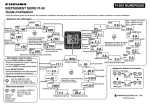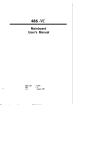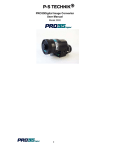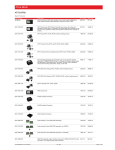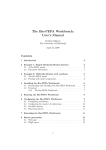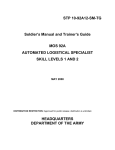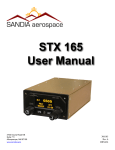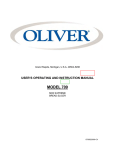Download Printable Format (User Manual)
Transcript
SPORTY'S E6B ELECTRONIC FLIGHT COMPUTER SOFTWARE Sporty's E6B Flight Computer software is designed to perform 23 aviation functions and 14 standard conversions, and includes timer and clock functions. This manual is designed to offer an introduction to the operation of the E6B software. For each calculation, a sample problem has been given. We hope that you enjoy your Sporty's E6B Flight Computer software. Its use has been made easy through direct path menu selection and calculation prompting. As you will soon learn, it is one of the most useful and versatile of all aviation computers. © 2008 by Sportsman's Market, Inc. Version 08A CONTENTS Display Screens ................................................................................ 2 Aviation Functions ............................................................................. 2 Prompts and Labels ........................................................................... 3 Special Function Keys ........................................................................ 4 Conversions ...................................................................................... 4 Clocks and Timer ............................................................................... 5 Adding and Subtracting Time .............................................................. 5 Percent MAC (%MAC) ......................................................................... 6 Pressure and Density Altitude (P/D-Alt) .............................................. 6 Flight Plan True Airspeed (PLAN TAS) .................................................. 7 Heading and Groundspeed (HDG/GS) .................................................... 7 Leg Time (LEG TIME) .......................................................................... 8 Fuel Required (FUEL REQ) ................................................................... 8 Crosswind, Headwind and Tailwind (X/H-Wind) ...................................... 8 Actual True Airspeed (ACT TAS) ......................................................... 9 Wind Speed and Direction (WIND) ........................................................ 9 Groundspeed (GS).............................................................................10 Fuel Per Hour (FPH) ..........................................................................10 Flight Plan Mach Number (PLAN M#) ...................................................10 Required True Airspeed (REQ TAS) .....................................................11 Required Calibrated Airspeed (REQ CAS) .............................................11 Distance Flown (DIST FLN) ................................................................12 Endurance (ENDUR) ...........................................................................12 Actual Mach Number (ACT M#)...........................................................12 Required Rate of Climb (RteOClimb) ...................................................13 Required Rate of Descent (Req/Dscn) .................................................13 Specific Range (SPRNG) .....................................................................14 Top of Descent (T-DCN) ....................................................................14 Weight/ARM (WT/ARM) .....................................................................15 Weight/Moment (WT/MOM) ................................................................16 Appendix A: Sample Problems .......................................................17-20 Weight and Measure Conversions. .......................................................20 Troubleshooting and Information ........................................................21 Page 1 DISPLAY SCREEN E6B PalmVersion WT/ARM WT/ARM WT/MOM %MAC WT/ARM P-D/ALT WT/ARM PLAN TAS HDG/GS WT/ARM LEG TIME WT/ARM FUEL REQ X/H-WIND WT/ARM ACT TAS WT/ARM WIND GS WT/ARM FPH WT/ARM PLAN M# REQ TAS WT/ARM REQ CAS WT/ARM DIST FLN ENDUR WT/ARM ACT M# WT/ARM Clk/Tmr Rte O Climb SPRng Req/Dscn T-DCN The figure above shows the main menu. To choose a function, press the appropriate button with the stylus pen. The display will change to the function showing the values to be entered at the top, the calculated values shown below the line and the entry keypad (shown below) at the bottom of the screen. 7 8 9 + 4 5 6 - +/- Timer 1 2 3 X : Conv 0 . = ÷ Ent C Main Your E6B software performs all of the basic arithmetic functions with the keys shown above (addition, subtraction, multiplication, and division). These functions, as well as any conversions, can be performed at any time while performing an aviation function. The E6B software will display up to eight digits of the answer. The = button should be used to compute any arithmetic function. Page 2 AVIATION FUNCTIONS The aviation functions are displayed on the main menu. Your E6B software will automatically save computed values from one aviation function to another. To override this option, key in the new value when prompted. The E6B software will save true airspeed, groundspeed, time, and fuel per hour calculations. It will also save cumulative weight and balance totals. PROMPTS AND LABELS WT: Weight I°C: Indicated Temperature in Celsius W SPD: Wind Speed MOM: Moment RWY: Runway CG: Center of Gravity X-WIND: Crosswind GS: Groundspeed H-WIND: Headwind HDG: Heading W DIR: Wind Direction P ALT: Pressure Altitude ARM: Arm T°C: Temperature in Celsius CAS: Calibrated Airspeed CRS: Course TAS: True Airspeed RF: Reduction Factor MACH#: Mach Number GW: Gross Weight D ALT: Density Altitude or Desired Altitude DIST: Distance %MAC: Percent Mean Aerodynamic Chord HOME: Home Time Clock Label FPH: Fuel Per Hour TIME: Time I ALT: Indicated Altitude MAC: Mean Aerodynamic Chord FUEL: Fuel LOCAL: Local Time Clock Label °C: Temperature in Celsius Label FEET: Feet Page 3 NAUT: Nautical CONV: Conversion Function RGR: Required Gradient Rate MROC: Minimum Rate of Climb CRALT: Crossing Altitude FXDIS: Fix Distance RQ/DN: Required Descent Rate SPRNG: Specific Range RATE: Descent Rate T-DSC: Top of Descent LEMAC: Leading Edge Mean Aerodynamic Chord ZULU: Coordinated Universal Time Clock Label BARO: Altimeter Setting in Inches in Mercury (Barometer) SPECIAL FUNCTION KEYS Clk/Tmr Displays clocks and timer. Main Returns to main menu. Conv Converts the value between units of measurement. Timer Imports current value from timer onto current number entry line. Ent = Accepts the entered number. Totals calculator functions. Deletes last digit entered. C Clears current number entry line. Moves cursor between number entry lines. +/- Changes a positive value to a negative and a negative value to a positive. A negative number will be denoted with a minus sign in front of the number. Page 4 CONVERSIONS Conversions may be made at any time during any function. For example, if a calculation prompts for the temperature in Celsius and only 68° Fahrenheit is available, enter 68 as the value, press Conv , press F C . 20.00 will be displayed on the top line. Press Return to accept this value and return to the calculation. Conversions can be calculated for: Nautical Miles Statute Miles Nautical Miles Kilometers Feet Statute Miles Kilometers Statute Miles Meters Pounds Kilograms Gallons Fahrenheit Hours Nautical Miles Meters Feet Kilograms Pounds Liters Liters Gallons Celsius Celsius Hours, Minutes, Seconds Fahrenheit Hours, Minutes, Seconds Hours There are no conversion keys for kilometers to statute miles or statute miles to kilometers. To convert from kilometers to statute miles, first convert kilometers to nautical miles, then nautical miles to statute miles. To convert statute miles to kilometers, first convert from statute miles to nautical miles, then nautical miles to kilometers. CLOCKS AND TIMER The E6B software has three clocks that run simultaneously. They are labeled as Zulu, Home and Local. The independent timer is below the clocks. To display, press . Clk/Tmr To set 11:25:00 on Zulu clock, tap under the hour position until 11 is displayed. Tap under the Set minutes position until 25 is displayed. Press to start the clock. This also synchronizes the minutes and seconds of the Home and Local clocks with the Zulu clock. Set the hours for the Home and Local clocks using Set tapping on the Zulu clock. A time can be entered in the timer by using counting up or tap Down , then synchronize the minutes and seconds by . To activate the timer, tap to start counting down. Stop Up pauses the timer. to start the timer returns the timer Reset to 0:00:00. An indicator to the right of the timer indicates if the timer is counting up ( ) or counting down ( ). indicates the timer is stopped. Next to this indicator is a + or -. When the timer is counting down and reaches 0:00:00, this changes from + to - to show the timer is now counting how much time has passed since reaching zero. The count down timer can be used as a reminder when to switch fuel tanks, to fly a non-precision approach (LEG TIME function) or measuring groundspeed from one checkpoint to another checkpoint (GS). Any function requiring time to be entered, the timer may be used by tapping prompted for time. Page 5 Timer , Ent when ADDING AND SUBTRACTING TIME Time can be entered into the E6B software in either hours or hours, minutes and seconds. To enter in hours, simply key in a normal decimal number. For example, entering 2.75 hours is the same as entering 02:45:00. : To key in time in hours, minutes and seconds mode, the hours, 14 minutes and 25 seconds, tap 3, : : , 1, 4, must be used. For example, to enter 3 , 2, 5. The display will read 3:14:25. To key in 5 minutes even, the leading zeroes must be used: tap 0, : , 0, 5. The display will read 0:05. Time can be added in either mode; times from different modes can also be added without converting. For example, to add 3.45 hours and 2:45:00 : Enter in 3.45 and tap + Enter in 2:45 and tap = The diplay will read 6.2. Answers will always appear in hours. Use the conversion function H HMS to change to hours, minutes and seconds. The display will read 6:12:00. PERCENT MAC (%MAC) This function computes the center of gravity in terms of percentage of mean aerodynamic chord, or the percentage distance of the center of gravity from the average distance between the leading edge to the trailing edge of the wing. In this example, leading edge mean aerodynamic chord (LEMAC) is 22.29, the CG is 37.27, and the mean aerodynamic chord (MAC) is 61.4. Tap %MAC WT/ARM from the main menu. The display will prompt for LEMAC. Key in 22.29 and press The display will prompt for CG. Key in 37.27 and press Ent . The display will prompt for MAC. Key in 61.4 and press Ent . The display will read: Page 6 Ent . LEMAC CG MAC %MAC 22.29 37.27 61.4 24.4 The total for %MAC should be checked against the aircraft’s approved operating limits. ______________________________________________________________________________ PRESSURE AND DENSITY ALTITUDE (P-D/ALT) This function will compute the pressure and density altitude given the indicated altitude, barometric pressure (altimeter setting in inches of Mercury), and temperature in Celsius. In this example, indicated altitude is 10,000 feet, the barometer is 29.94 inches, and the temperature is 5°C. Tap P-D/ALT WT/ARM from the main menu. The display will prompt for IAlt. Key in 10000 and press The display will prompt for BARO. Key in 29.94 and press The display will prompt for T°C. Key in 5 and press Ent . Ent . Ent . The display will read: IAlt BARO T°C PAlt DAlt 10000 29.94 5 9980 11088 FLIGHT PLAN TRUE AIRSPEED (PLAN TAS) This function is used to calculate true airspeed for preflight planning. It will compute the density altitude, mach number and true airspeed in knots, given the pressure altitude, temperature, and calibrated airspeed in knots. In this example, pressure altitude is 10,000 feet, temperature is 2°C, and CAS is 200 knots. Tap PLAN TAS from the main menu. The display will prompt for PAlt. Key in 10000 and press The display will prompt for T°C. Key in 2 and press Ent . Page 7 Ent . The display will prompt for CAS. Key in 200 and press Ent . The display will read: PAlt T°C CAS DAlt Mach# TAS 10000 2 200 10770 0.36 234.7 ______________________________________________________________________________ HEADING AND GROUNDSPEED (HDG/GS) This function will compute heading and groundspeed given wind direction, wind speed, course, and true airspeed. In this example, the wind is from 270° at 20, course is 180°, and true airspeed is 185. Tap HDG/GS WT/ARM from main menu. The display will prompt for W D i r . Key in 270 and press Ent . Ent . The display will prompt for W S p d . Key in 20 and press The display will prompt for C R S . Key in 180 and press Ent . The display will prompt for TAS. Key in 185 and press Ent . The display will read: WDir WSpd CRS TAS HDG GS 270 20 180 185 186.2 183.9 LEG TIME (LEG TIME) This function computes the time required to fly a particular distance given distance and groundspeed. In this example, distance is 25 and groundspeed is 185. Page 8 Tap LEG TIME WT/ARM from the main menu. The display will prompt for Dist. Key in 25 and press The display will prompt for GS. Key in 185 and press Ent . Ent . The display will read: Dist GS Time 25 185 0.1351351 0:08:06 Note: The calculated time is displayed in both hours and hours, minutes, seconds. ______________________________________________________________________________ FUEL REQUIRED (FUEL REQ) This function calculates fuel requirements given time and fuel per hour consumption. In this example, flying time is 3 hours 15 minutes and fuel per hour consumption is 14 gallons. Tap 3, FUEL REQ : from the main menu. The display will prompt for Time. Key in 3 hours, 15 minutes. Tap , 1, 5 and press Ent . The display will prompt for FPH. Key in 14 and press Ent . The display will read: Time FPH Fuel 3:15 14 45.5 Note: The Fuel Required function computes the fuel consumption only. It does not take required fuel reserves into account. ______________________________________________________________________________ CROSSWIND, HEADWIND AND TAILWIND (X/H-WIND) This function computes the crosswind component and headwind or tailwind component given wind direction, wind speed and runway number. In this example, the wind is from 270° at 20, and the runway number is 30. Note that the runway heading of 30 should be entered, not 300. Tap X/H-WIND WT/ARM from the main menu. The display will prompt for WDir. Key in 270 and press The display will prompt for WSpd. Key in 20 and press The display will prompt for RWY. Key in 30 and press Ent . Ent . The display will read: WDir WSpd RWY H-Wind X-Wind 270 20 30 -17.3 -10 Page 9 Ent . Right crosswinds are shown as positive numbers, while left crosswinds are shown as negative numbers. A positive value for H-WIND denotes a tailwind, while a negative value denotes a headwind. ACTUAL TRUE AIRSPEED (ACT TAS) This function calculates true airspeed, mach number and density altitude given pressure altitude, indicated temperature in Celsius and calibrated airspeed. In this example, the pressure altitude is 10,000 feet, temperature is 3°C, and calibrated airspeed is 200. Tap ACT TAS WT/ARM from main menu. The display will prompt for P A l t . Key in 10000 and press The display will prompt for I ° C . Key in 3 and press Ent . Ent . The display will prompt for C A S . Key in 200 and press Ent . The display will read: PAlt I°C CAS DAlt Mach# TAS 10000 3 200 10039.6 0.36 232 ______________________________________________________________________________ WIND SPEED AND DIRECTION (WIND) This function calculates wind speed and direction given course, true airspeed, groundspeed, and heading. In this example, the course is 355°, true airspeed is 200, groundspeed is 170, and the heading is 350°. Tap WIND from main menu. The display will prompt for C R S . Key in 355 and press The display will prompt for T A S . Key in 200 and press The display will prompt for G S . Key in 170 and press The display will prompt for HDG. Key in 350 and press Ent . Ent . Ent . The display will read: CRS TAS 355 200 Page 10 Ent . GS HDG WDir WSpd 170 350 324.2 34 GROUNDSPEED (GS) This function calculates groundspeed given distance and time. In this example, distance is 18, and time is 7 minutes. Tap from the main menu. The display will prompt for Dist. Key in 18 and press GS The display will prompt for Time. Key in 7 minutes. Tap 0, : , 0, 7 and press Ent . Ent . The display will read: Dist Time GS 18 0:07 154.3 NOTE: Time can be imported from the timer for groundspeed calculations. This can be done by tapping Timer , Ent when the computer prompts for time. ______________________________________________________________________________ FUEL PER HOUR (FPH) This function computes fuel per hour given time and total fuel consumed. In this example, time is 3 hours 15 minutes, and fuel consumed is 45.5 gallons. Tap FPH WT/ARM from the main menu. The display will prompt for Fuel. Key in 45.5 and press The display will prompt for Time. Key in 3 hours, 15 minutes. Tap 3, : , 1, 5 and press Ent . Ent . The display will read: Fuel Time FPH 45.5 3:15 14 ______________________________________________________________________________ Page 11 FLIGHT PLAN MACH NUMBER (PLAN M#) This function will compute the true airspeed given the temperature in Celsius and the mach number. In this example, temperature is -20°C and the Mach# is 0.85. Tap PLAN M# from the main menu. The display will prompt for T°C. Key in 20, press +/- and press Ent . Ent . The display will prompt for Mach#. Key in 0.85 and press The display will read: T°C Mach# TAS -20 .85 527.2 REQUIRED TRUE AIRSPEED (REQ TAS) Required True Airspeed is a planning function used to maintain a certain groundspeed and course in order to arrive at a desired point at a specific time. It will compute true airspeed and heading given wind direction and speed, course, and groundspeed. In this example, the wind is from 270° at 15, course is 355°, and groundspeed is 225 kts. Tap REQ TAS WT/ARM from main menu. The display will prompt for W D i r . Key in 270 and press Ent . The display will prompt for W S p d . Key in 15 and press Ent . The display will prompt for C R S . Key in 355 and press The display will prompt for GS. Key in 225 and press Ent . Ent . The display will read: WDir WSpd CRS GS TAS HDG 270 15 355 225 226.8 351.2 ______________________________________________________________________________ REQUIRED CALIBRATED AIRSPEED (REQ CAS) Page 12 This function calculates the calibrated airspeed, corresponding mach number, and density altitude given the pressure altitude, temperature in Celsius, and true airspeed. In this example, pressure altitude is 10,000 feet, temperature is 2°C, and the true airspeed is 200. Tap REQ CAS WT/ARM from main menu. The display will prompt for P A l t . Key in 10000 and press The display will prompt for T ° C . Key in 2 and press Ent . Ent . The display will prompt for T A S . Key in 200 and press Ent . The display will read: PAlt T°C TAS DAlt Mach# CAS 10000 2 200 10769.5 0.31 170.4 DISTANCE FLOWN (DIST FLN) This function calculates for distance given time and groundspeed. In this example, the groundspeed is 185 and time is 15 minutes. Tap DIST FLN from the main menu. The display will prompt for GS. Key in 185 and press The display will prompt for Time. Key in 15 minutes. Tap 0, : , 1, 5 and press Ent . Ent . The display will read: GS Time Dist 185 0:15 46.3 ______________________________________________________________________________ ENDURANCE (ENDUR) This function calculates endurance given the total fuel on board and the fuel per hour consumption. In this example, fuel on board is 74, and fuel per hour is 14. Tap ENDUR WT/ARM from the main menu. The display will prompt for Fuel. Key in 74 and press Page 13 Ent . The display will prompt for FPH. Key in 14 and press Ent . The display will read: Fuel FPH Time 74 14 5.2857143 5:17:09 Note: The calculated time is displayed in both hours and hours, minutes, seconds. ______________________________________________________________________________ ACTUAL MACH NUMBER (ACT M#) This function calculates true airspeed given the indicated temperature and mach number. It differs from the PLAN M# function only in that indicated temperature is used. In this example, the indicated temperature is -17°C and the mach number is 0.85. Tap ACT M# WT/ARM from the main menu. The display will prompt for I°C. Key in 17, press +/- and press Ent . The display will prompt for Mach#. Key in 0.85 and press Ent . The display will read: I°C Mach# TAS -17 .85 502.2 REQUIRED RATE OF CLIMB (Rte O Climb) This function calculates required rate of climb (common in departure procedures) in feet per minute given groundspeed and required climb gradient in feet per mile. In this example, the groundspeed is 80 and the required climb gradient is 330 feet per mile. Tap RteOClimb from the main menu. The display will prompt for GS. Key in 80 and press The display will prompt for RGR. Key in 330 and press Ent The display will read: GS RGR MROC GRAD 80 330 440 5.4% Page 14 . Ent . ______________________________________________________________________________ REQUIRED RATE OF DESCENT (Req/Dscn) This function determines the required descent or climb rate to arrive at a fix at a specific altitude given groundspeed, indicated altitude, crossing altitude and fix distance. In this example, the aircraft is cruising at 14,000 feet with a groundspeed of 180. ATC assigns a crossing altitude of 8,000 feet for a fix located 25 miles away. Tap Req / Dscn from the main menu and the display will prompt for GS. Key in 180 and press Display will prompt for IALT. Key in 14,000 and press Ent . Display will prompt for CRALT. Key in 8,000 and press Display will prompt for FXDIS. Key in 25 and press Ent . Ent . Ent . The display will read: GS IALT CRALT FIXDIS RQ/DN 180 14000 8000 25 720 This ATC crossing restriction will require a descent rate of 720 feet per minute. A positive value for RQ/DN indicates a descent. A negative value indicates a climb to the crossing altitude. SPECIFIC RANGE (SPRNG) Specific range is a planning function used to determine the most desirable altitude for long range flight. Range is calculated in miles given the total fuel, groundspeed and fuel burn. In this example, we will compute aircraft range at 12,000 feet with 140 gallons of fuel. Our fuel burn will be 24 gallons per hour with a groundspeed of 150. Page 15 Tap Ent . from the main menu and the display will prompt for FUEL. Key in 140 and press SPRNG Ent . Display will prompt for GS. Key in 150 and press Display prompts for FPH. Enter 24 and press Ent . The display will read: FUEL GS FPH SPRNG 140 150 24 875 This cruise altitude will yield a range of 875 miles. Following the same sequence for a flight at 8,000 feet with 140 gallons of fuel, a groundspeed of 165, and fuel burn of 27 gallons per hour, a specific range of 855.6 is calculated. An additional 20 miles of range is available at 12,000 feet. ______________________________________________________________________________ TOP OF DESCENT (T-DCN) This function determines when to begin a descent to arrive at the destination at a desired altitude given aircraft groundspeed, indicated altitude, desired altitude and rate of descent. In this example, our indicated altitude is 11,500 feet. We desire to be at a pattern altitude of 1,500 feet descending at 600 feet per minute with a groundspeed of 140. Tap T-DCN from the main menu and the display will prompt for GS. Key in 140 and press Display will prompt for IALT. Key in 11,500 and press Display will prompt for DALT. Key in 1,500 and press Display will prompt for RATE. Key in 600 and press Ent Ent Ent . The display will read: GS IALT DALT RATE T-DSC 140 11500 1500 600 38.9 The descent should begin 39 miles from our destination. Page 16 . . Ent . WEIGHT/ARM (WT/ARM) This function is an easy method to compute the proper loading of the aircraft. The E6B software will retain and display cumulative totals for center of gravity, (CG), gross weight (GW), and moment (MOM). This will allow you to continue keying in weight and ARM values for to obtain running totals. In the WT/ARM mode, the E6B software continuously prompts for new WT and ARM values. ARM is the distance in inches from the datum line to the center of gravity of an item. The datum line is an imaginary line established by the manufacturer from which all ARM measurements are taken. The moment is the product of arm and weight, divided by the reduction factor. The reduction factor is a constant of 1 for WT/ARM calculations. The computer will always assume RF=1. In this example, aircraft empty weight is 2467, arm is 76.7", and the reduction factor is 1. Tap from main menu. The display will prompt for W T . Key in 2467 and press WT/ARM WT/ARM The display will prompt for A R M . Key in 76.7 and press WT ARM CG MOM GW Ent . Ent . The display will read: 2467 76.7 76.7 189218.9 2467 After keying in the airplane's empty weight and arm, the next step is to calculate the weight and balance for the aircraft at takeoff. For this example, we'll assume the following load: Item Weight Fuel Front passengers Rear passengers Baggage Arm 72.5 gal (6 lbs./gal.) 340 340 18 75 75 115 164 With display from the previous page shown: Key in 7 2 . 5 X 6 Key in A R M of 7 5 . Press = ; W T will display 4 3 5 . Press Ent Ent . . New totals will appear for MOM, CG and GW. The passengers and baggage can be added onto the total in the same manner the fuel was added above. The final calculations can be used to confirm that the weight and CG are within the aircraft's operating limitations. When finished, the cumulative totals will be displayed. The display will read: WT ARM CG MOM GW 18 164 80.39 289395.9 3600 Weight can also be moved or subtracted. Suppose one of the rear passengers can’t make the trip: Page 17 Key in W T of 1 7 0 a n d p r e s s Key in A R M of 1 1 5 . Press Ent +/- ; Press . Ent . The display will read: WT ARM CG MOM GW -170 115 78.67 269845.9 3430 WEIGHT/MOMENT (WT/MOM) This function is similar to the (WT/ARM) function. However, flight manuals for some aircraft describe weight and balance problems in terms of moments. Sporty's E6B software will retain and display cumulative totals for center of gravity, gross weight and moment given weight and moment for each item and reduction factor. The reduction factor for this example is 100. As an example, use the following table for entry: ITEM Empty weight Seat #1 Seat #2 Seat #3 Seat #4 Baggage, nose compartment Baggage, rear compartment Fuel, main tanks Fuel, auxiliary tanks Tap WT/MOM WEIGHT 3472 170 160 100 120 100 60 600 378 MOM/100 1220 63 59 68 82 -31 74 210 178 from main menu. The display will prompt for W T . Key in 3472 and press The display will prompt for M O M . Key in 1220 and press The display will prompt for R F . Key in 100 and press Ent . Ent . Ent . The display will read: WT MOM RF CG GW 3472 1220 100 35.14 3472 Enter remaining weights and moments. Since the RF has already been keyed in, the computer will not prompt for RF after the first entry. The E6B software will keep running totals for moment, center of gravity and gross weight. When finished, the display will read: WT MOM RF CG GW 378 1923 100 37.27 5160 Totals for moment, center of gravity, and gross weight should then be checked against the aircraft's approved operating limits. Page 18 APPENDIX A SAMPLE PROBLEMS TIME 4:45:00 + 2:15:30 = CONV H->HMS = 6.7 - 5:20:00 = CONV H->HMS = 07:00:30 01:22:00 CONVERSIONS 25 pounds to kilograms.....................................11.3398 12 kilograms to pounds.....................................26.4554 30 feet to meters ............................................... 9.144 100 meters to feet ..........................................328.084 32° Fahrenheit to Celsius..............................................0° 100° Celsius to Fahrenheit ..................................... 212° 100 nautical miles to kilometers ........................... 185.2 50 kilometers to nautical miles .........................26.9978 9.5125 hrs to hms ............................................. 9:30:45 12:30:30 hms to hrs .........................................12.5083 87 nautical miles to statute miles.....................100.117 115 statute miles to nautical miles .................99.9322 1 U.S. gallon to liters .........................................3.78541 10 liters to U.S. gallons ....................................2.64172 INPUT OUTPUT % M A C (use CG from WT/MOM problem) LEMAC CG MAC 285.6 308.08 81.0 %MAC 27.8 P-D/ALT Page 19 IAlt BARO T°C 10000 30.00 5 PAlt DAlt 9920 11014 12000 2 195 DAlt Mach# TAS 13219 0.37 237.7 PLAN TAS PAlt T°C CAS HDG/GS WDir WSpd CRS TAS 270 20 355 195 HDG GS 25 195 Time 0.1282051 0:07:42 349.1 192.2 LEG TIME Dist GS FUEL REQ Time FPH 02:45:00 14 Fuel 38.5 APPENDIX A (cont.) SAMPLE PROBLEMS INPUT X/H-WIND WDir WSpd RWY OUTPUT 270 20 30 H-Wind X-Wind -17.3 -10 ACT TAS PAlt I°C CAS 12000 2 195 DAlt Mach# TAS 12367.9 0.37 234.5 WIND CRS TAS GS HDG 355 195 175 349 WDir WSpd 307.8 27.8 GS Page 20 Dist Time 32 00:15:00 GS 128 33 02:45:00 FPH 12 TAS 482.8 TAS HDG 194.8 349.1 DAlt Mach# CAS 9457 0.28 160.7 Dist 476.7 FPH Fuel Time PLAN M# T°C Mach# -45 0.82 REQ TAS WDir W Spd CRS GS 270 20 355 192 REQ CAS PAlt T°C TAS 8000 12 185 DIST FLN GS Time 220 02:10:00 APPENDIX A (cont.) SAMPLE PROBLEMS INPUT OUTPUT ENDUR Fuel FPH 70 14 Time 5 5:00:00 ACT M# I°C Mach# -52 0.82 TAS 451.7 RteOClimb Page 21 GS RGR 70 400 MROC Grad% 460.8 6.6% 220 20000 11000 25 RQ/DN 1320 2500 280 700 SPRNG 1000 230 22000 1000 1500 T-DSC 53.7 Req/Dscn GS IALT CRALT FIXDIS SPRNG FUEL GS FPH T-DCN GS IALT DALT RATE WT/ARM empty fuel front seat 2nd row 3rd row baggage WT 2467 444 340 0 0 100 ARM 76.7 75.0 75.0 115 148 164 MOM 189218 222518 248018 GW 2467 2911 3251 264418 3351 CG = 78.91 APPENDIX A (cont.) SAMPLE PROBLEMS WT/MOM Payload computations ITEM WEIGHT (pounds) MOMENT /1000 Page 22 Basic operating weight 8916 2809.0 Cabin Seat 3 Seat 4 Seat 5 Seat 6 170 160 190 110 37.7 35.5 50.5 29.3 Baggage Nose Tail cone 60 110 4.4 50.8 9716 5424 15140 -200 14940 -2000 12940 3017.2 1644.1 4661.3 -61.8 4599.5 -612.9 3986.6 Zero fuel weight + Fuel = Ramp weight — Taxi fuel = Takeoff gross weight — En Route fuel = Landing weight CG = 308.08 WEIGHT AND MEASURE CONVERSIONS 1 inch = 2.54 centimeters 1 centimeter = 0.3937 inches 1 statute mile = 1.61 kilometers 1 kilometer = 0.62 statute miles 1 U.S. gallon = 0.833 Imperial gallons 1 Imperial gallon = 1.201 U.S. gallons 1 liter = 0.22 Imperial gallons 1 Imperial gallon = 4.55 liters 1 ounce = 28.35 grams 1 gram = 0.035 ounces 1 inch of Mercury = 33.86 millibars 1 millibar = 0.0295" of Mercury Page 23 TROUBLESHOOTING & INFORMATION Improper input of data will cause incorrect answers. Read the operating instructions to ensure that you are entering problems correctly. Also be sure that units agree, i.e., all units in statute miles, nautical miles, or kilometers. NOTE: Sporty's E6B software is an instruction and informational aid, and is not an avionics instrument. Page 24
























